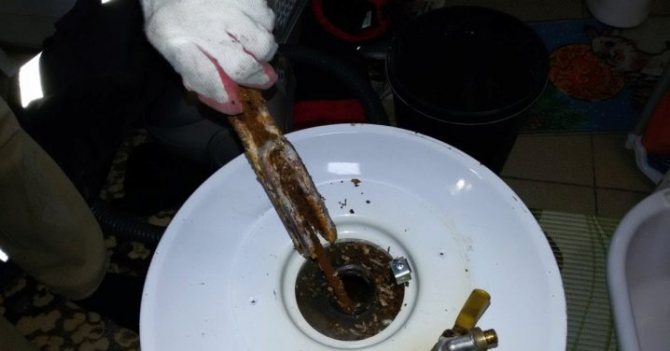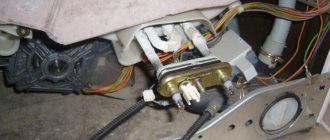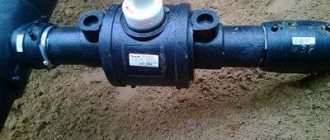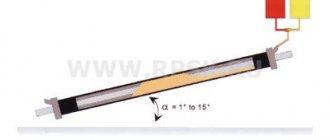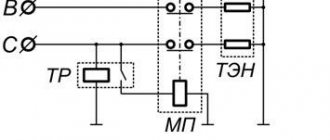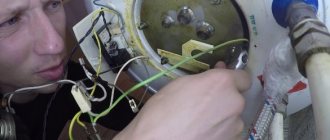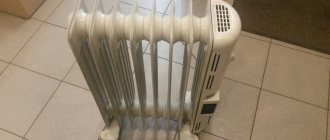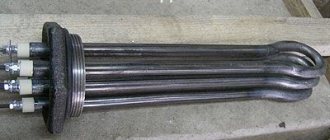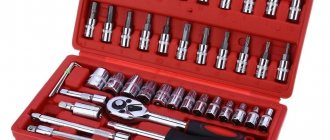From the article you will learn what a heating element is, for what purposes it is used, how it is connected. You will also learn about what kind of design it has. In short, this is an electric heating device, and the abbreviation itself stands for quite simply. It is a tubular electric heater. It bears this name for the reason that often these elements are made in the form of ceramic, glass or metal tubes. Now let's take a closer look at all the components of this electrical appliance.
Element design
The article shows a diagram of a heating element. The most important component of any heating element is the heater itself, made of nichrome thread, which is located inside the tube along its entire length. The ends of the thread are attached to the output pins. The nichrome thread has a certain resistance, when a current begins to flow through it, it heats up, and gives off heat to a metal or ceramic holder.

It should be noted that the material from which the tube is made must have a high current resistance. Therefore, it is made from alloys that include constantan or nichrome. The resistance of the heating element depends on how much power the device needs to develop.
What heaters are installed in Termeks boilers
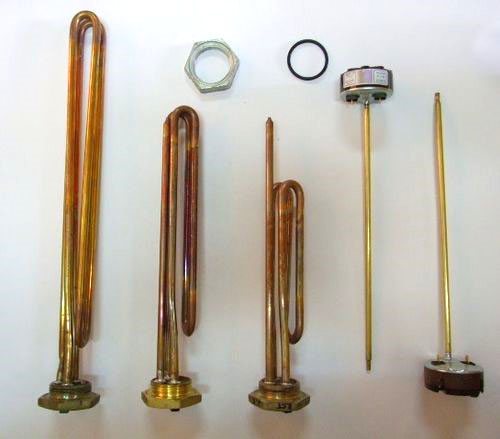

The company uses heating elements for the Termeks water heater from various manufacturers. In addition to the Italian site, the production of electrodes was launched in China. There is a control laboratory at the exit. Low resistance elements are rejected.
For a greater guarantee at home, before installing the heaters, they need to be kept in water for several hours and check whether the resistance corresponds to that specified in the passport.
The following types of heating elements are produced for Termeks water heaters:
- for flow-through taps, heaters with a capacity of 3.3, 2.5, 5.5 kW;
- on a stamped flange D 64 mm - 2.0 1.5 kW, D 82 mm - 1.5 kW, D 92 mm - 1.5, 2.0 kW;
- without flanges, with fastening on nuts - 0.7, 1.3, 2.0 kW;
- magnesium anodes of a special composition, only in Italy.
The company has developed a special composition for the production of AZ63 plus alloy anodes, which are 2 times more efficient than conventional anodes.
Calculation of heater parameters
Ohm's law calculates the power, which is equal to the product of the current strength and the voltage of the electrical network. In other words, in order for the heating element to have a power of 1000 W, you must first calculate the current strength. There are two known parameters - power and voltage (in the household network - 220 volts). The current will be equal to the power divided by the voltage. If 1000/220, we get a current strength equal to 4.55 A.
In order to determine the resistance of the thread, it is necessary to divide the voltage by the current strength. As a result, we get the resistance of the heating element winding, expressed in ohms. More precisely, we divide 220 by 4.55 and we get that the resistance of the nichrome thread should be equal to 48.4 ohms.
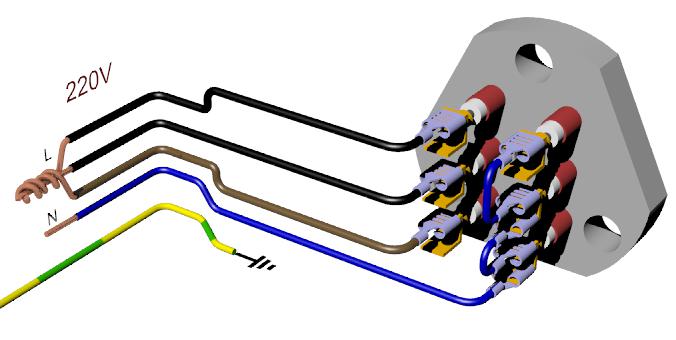

It should be noted that resistance directly affects the power of the heating element. The lower the resistance value, the greater the power of the heating element. It is necessary to pay attention to the fact that almost all the power will be spent on heating the thread. Therefore, the efficiency of most heating elements is almost 100%. In other words, the more powerful the heating device, the faster and more it warms up.
Teng
I
(Taine)
Hippolyte Adolphe (21.4.1828, Vouzier, Ardennes, - 5.3.1893, Paris), French philosopher, esthetician, writer, historian. From 1848 to 1851 he studied at the Higher Normal School (Paris). Member of the French Academy (1878). The founder of the aesthetic theory of Naturalism, the founder of the cultural-historical school (see. The cultural-historical school).Major works - "Critical Experiments" (1858, Russian translation 1869), sketches about O. Balzac (1858) and Stendhal (1864), "History of English Literature" (1863-1864, Russian translation 1876), "Philosophy art ”(1865-69, Russian translation 1866, 1899). Based on the positivist evolutionism of O. Comte, T. considered the task of criticism "neutral" analysis, avoiding moral and ideological assessments.
The basis of his methodology is the triad: "race" (that is, innate, "natural" qualities), "environment" (geographic and climatic conditions), "moment" (the existence of "race" and "environment" in a certain historical epoch). The interaction of the members of the triad determines the emergence of styles, genres, schools. The artistic work of T. bears the stamp of elite indifference to the life of the people. The author of the essay books "The Pyrenees Journey" (1855), "Travel in Italy" (1866, Russian translation 1913-16), the satirical story "Parisian Manners. The Life and Reflections of Frederick Thomas Grandorge (1867, Russian translation, 1880), Sketches of Modern England (1871, Russian translation, 1872), Travel Diary (1897). Speaking until the 70s. from moderately liberal positions, T. after the Paris Commune of 1871, which he met with hostility, evolved towards reaction. This turning point was reflected in the main historical work of T. - "The Origin of Modern France" (v. 1-3, 1876-93, Russian translation, v. 1-5, 1907). Based on a tendentious selection of sources, T.'s work is essentially a pamphlet against the Great French Revolution, against the Jacobins and the Jacobin dictatorship.
Cit .: La Fontaine et ses fables, P., 1861; Sa vie et sa correspondence, v. 1-2, 4 е́d..P., 1908-14; in Russian per. - Balzac, St. Petersburg. 1894; History of aesthetics. Monuments of world aesthetic thought, vol. 3, M., 1967.
Lit .: Plekhanov G. V., Literature and aesthetics, t. 1-2, M., 1958; Lunacharsky A.V., Sobr. cit., t. 8, M., 1967; Anisimov I.I., Living life of the classics, M., 1974, p. 101-03; Aulard A., Taine, historien de la revolution française. P., 1907; Lacombe P., Taine, historien et sociologue. P., 1909.
V.P. Balashov.
I. Teng.
II
(chemical)
the same as Tetranitropentaerythritol.
Source: Great Soviet Encyclopedia on Gufo.me
Values in other dictionaries
- Taine - Hippolyte-Adolphe (Taine, 1828-1893) - the most outstanding and original of the thinkers of France in the 2nd half of the 19th century. Ten's father was a solicitor, his grandfather was a sub-prefect: T.'s ancestors are mentioned in the 17th century, one of them was given the nickname of a philosopher. Encyclopedic Dictionary of Brockhaus and Efron
- ten - TEN, -a (or -a), m., TENKA, -i, zh., TEN, -a, (or -a), m., TENKA, -i, zh. Ten thousand rubles (or ten dollars, ten thousand dollars). English ten - ten. Explanatory dictionary of Russian argo
- TEN - (Taine), Hippolyte (21.IV.1828 - 5.III.1893) - French. literary critic, philosopher and historian. Prof. art history at the École des Beaux-Arts in Paris (1864-84). Member Franz. academy (since 1878). Works T. 50-60-ies. Soviet Historical Encyclopedia
- Teng - Tetranitropentaerythritol (a.pentaerythrittetranitrate, nitropenta; n.Pentaerythrittetranitrat, Nitropenta; f. Tetrtanitropentaerythrol; and. Tetranitrato de pentaeritrita), - powerful blasting BB. It is a white crystalline. Mining encyclopedia
- ten - ten, -a and tan, -a Spelling dictionary. One N or two?
- TEN - see tetranitropentaerythritol Encyclopedia of Chemistry
- Taine - Taine Hippolyte (04.21.1828, Vouzier, Ardennes, -05.03.1893, Paris) - French philosopher, esthetician, historian, literary critic, social thinker. In his philosophical views, the positivist Teng was strongly influenced by Hegel. Sociological Dictionary
- Taine - Taine Ippolit (1828-93) - French philosopher, sociologist of art, historian. The founder of the cultural and historical school. Books: "Critical Experiments" (1858) - "Philosophy of Art" (1865-69) - "History of English Literature" (v. 1-4, 1863-64). Big encyclopedic dictionary
- ten - I. ten, shade teint m. outdated. Dyeing, coloring; color. Protchie < desains> just know how to copy, or change shadows, lizurs < lizere> and similar images on invented desseins ... Glossary of gallicisms of the Russian language
- ten - noun, number of synonyms: 7 explosive 232 vigilante 12 nitroether 1 pentaerythritol tetranitrate 5 pentrite 4 tan 2 tetranitropentaerythritol 4 Dictionary of Russian synonyms
- ten - orph.ten, -a Lopatin's Spelling Dictionary
- Taine - Taine (Taine) Hippolyte-Adolphe (April 21, 1828, Vouzier, Ardennes - March 5, 1893, Paris) - French philosopher, historian, theoretician of art and literature. Supporter of positivism, was influenced by Hegel. New Philosophical Encyclopedia
- Tain - Taine Hyppolyte (Hyppolyte-Adolphe Taine, 1828-1893) - French literary historian, historian, the largest representative of bourgeois art criticism of the XIX century, the creator of the so-called. cultural and historical method of studying literature and art. Literary encyclopedia
- Blog
- Jerzy Lec
- Contacts
- Terms of use
© 2005—2020 Gufo.me
Insulator and tube material
Between the tube and the nichrome thread is an insulator that can withstand very high temperatures. In order to make a tube for heating elements, it is necessary to choose materials that do not corrode. It is these tubular electric heaters that are most often used in industry and everyday life.
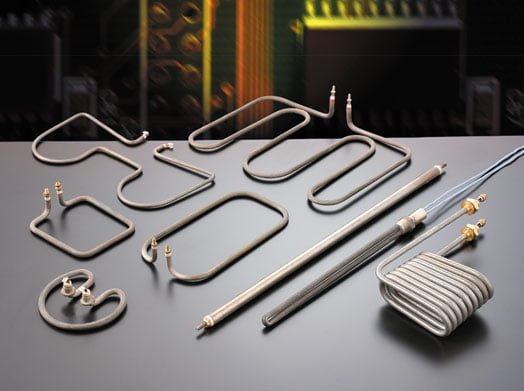

Enclosed in a glass tube are used, as a rule, in very aggressive environments, for example, in chemical laboratories, in which it is necessary to heat various mixtures. But you can also find them in household heaters. As a rule, they are used in devices using infrared type radiation. Ceramic tubes in heaters are used very rarely today.
Features of the
Electric water heaters are in great demand, due to which such products are presented in a wide variety on the market. The demand for such devices is due to the high cost of hot water supply, as well as the periodic shutdown of hot water in some areas.
The latest models of boilers have a special element, due to which water is heated in a closed container. It is an internal battery. Such a device is usually called a heating element. Based on the accepted abbreviation, the heating element stands for "tubular electric heater".
A device is assembled from a wire spiral, which is placed in a metal sheath, due to which the wires do not come into contact with water, but heat the tube. In the heater, such a part is inside, in contact with water during operation. As a result of the passage of current through the heating element, the liquid in the boiler is heated. The metal tube is usually made of "stainless steel" or copper alloy. Electric heaters are the main elements of any type of water heating tank. The electrical network acts as a power source for the device.
Everyone knows that water and electricity together pose a danger to humans, which is why manufacturers are trying to produce devices with a high level of safety.
Heating elements installed in water heaters can be of two types. Each type of element has its own specific characteristics.
Tube diameter
The tubes can have any diameter, but elements with a diameter in the range of 6-24 mm are widely used. In addition to the fact that the insulator must have high insulating properties, it is necessary that it effectively transfers heat from the heating coil to the tube. Now let's talk about what a heating element is and how it works.
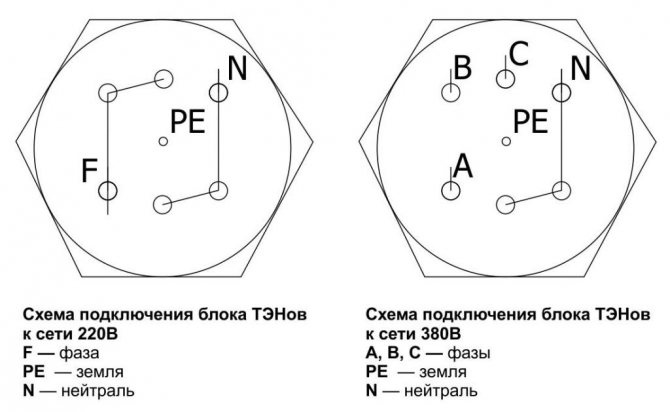

The power supply to the heating element is supplied using the terminals, which are located on the inserts with insulators. Terminals can be located at one end or both. There are varieties of tubular electric heaters that are equipped with built-in fuse protection. As a rule, such elements are installed in dishwashers or washing machines.
The device and application of thermoelements
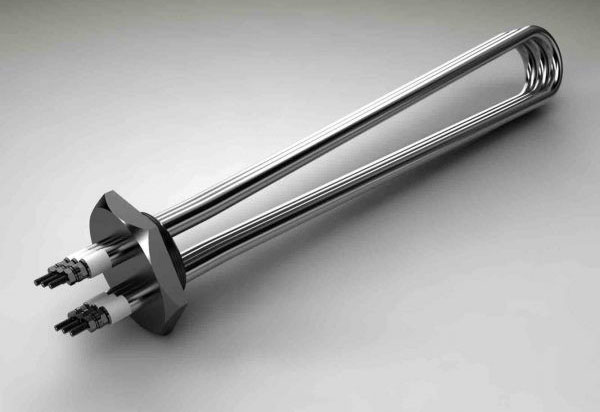

The resulting heating tube can be bent and the part made so that it can be installed in the vessel.In this case, the upper metal casing is made of a conductor with good heat transfer - steel, copper, alloys. The heating element for the water heater can be fixed in the vessel with a flange or both ends of the element with separate nuts. Any water, except distilled water, contains salts. Some of them, when heated, become insoluble and settle on metal tubes. The process also occurs because copper tubes are a catalyst for deposition.
If you put a rod of a more active metal next to it, then aggressive ions will come into contact with it. Then the magnesium anode electrode collapses, becomes covered with a loose crust, there are not enough ions for the formation of a deposit on the heating element. Thus, the service life of the main elements is extended, and the magnesium electrodes are replaced with new ones when worn. Therefore, all heating elements for a water heater are equipped with a magnesium anode.
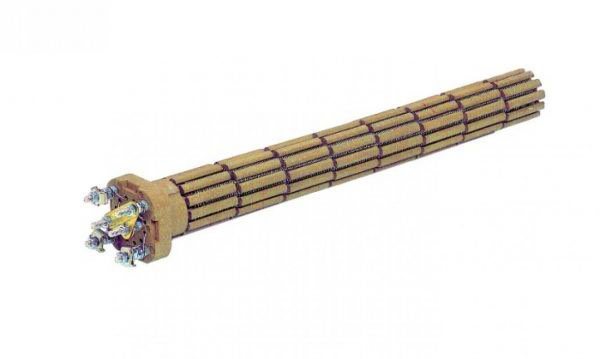

Dry heating elements have a different structure. They are immune to sediment, do not enter into electrochemical interaction with water, and do not overgrow even in a harsh environment. Accordingly, it is not necessary to install the anode element with them. These are not heating elements, since the device cannot be called a tubular electric heater. Such elements are prepared for a specific model of a water heater.
For air heating
For such heating elements, the temperature can reach 450 degrees. These tubular devices are used to heat the air in domestic and industrial premises. Such heating elements are the basis for the manufacture of convectors, various designs of drying chambers, air curtains. These heaters have smooth or finned tubes. What is a heating element for heating air, we will consider further.
The fins of these heaters are made from steel straps that are attached to the tube. Thanks to the use of ribs, it is possible to increase the surface area of the element, therefore, the load on the nichrome thread is significantly reduced, and the resource of the element also increases. At the same time, heat transfer increases significantly.
What is a heating element heating element. Advantages of heating elements
Compared to other types of heaters, heating elements have a lot of advantages. For example, they can be operated even when there is direct contact between the heater and the heated medium. And, as you know, these can be a wide variety of options, not just liquid and gaseous ones. The medium can even be solid, and the pressure in it can reach 4.5 atm. And this will not become an obstacle for the heating element.
The advantage of tubular electric heaters is also in reliable operation during vibrations, as well as when there are significant shock loads. In addition, they have different configurations. And there is no voltage on the shell of the heating elements.
There is such an important indicator as mean time to failure. When using heating elements for heating air media, it is at least 10 thousand hours. When used for heating liquid media - at least 5 thousand hours.
The two-end tubular heating element has such a design when the heating element is inside a metal shell. This is, for example, a coil or several coils made of a high resistance alloy. There are also contact rods.
The compressed electrically insulating filler acts as an insulator between the sheath and the heating element. In order to prevent the ingress of moisture from the environment, the ends of the heating elements are sealed. There are also dielectric insulators between the contact rods and the sheath.
Water heaters
When replacing the heating element of the washing machine, you can see that its design is completely sealed. Very often, such heating elements can be found both in washing machines and in boilers, heating appliances. Water can be heated in them to the boiling point, which is 100 degrees Celsius. If the volume of water is very large, block type devices are used.Quite often, together with the heating element, a temperature regulator is installed for the boiler.


With the help of a thermostat, it turns out to disconnect the heating element from the power supply when the liquid reaches the required temperature. As soon as the water cools down, the thermostat turns on the power again, and the coil begins to warm up. Such heating elements are used for heating boilers, boilers, in washing machines.
Device and types
In order to make the right choice when buying electrical equipment, it is necessary to study the characteristics of all available varieties. Heating elements are either closed or open.
Wet or open elements work by direct contact with the liquid in the tank. The configuration of the element has a classic look, a similar detail is present in any electric kettle. If a part of this group fails, its replacement does not require complex work. An open heating element contains magnesium oxide and silica sand inside its tube. These components belong to the type of heat-conducting substances. Nichrome wire acts as the basis for heating elements.


Manufacturers produce various open-type water heaters with heating elements. Based on the distinctive features of the products, the products can be classified.
- According to the method of fastening, the elements can be nut or flanged. The latter type is subdivided into cast and stamped products.
- An important point is the presence of an anode socket. Devices with a nut may not have an anode fastening, or they may be manufactured with additional fasteners on the flange.
- The form of heating elements can be standard straight or curved in different directions.
- According to the type of raw material for the tube, the elements can be made of copper or steel.
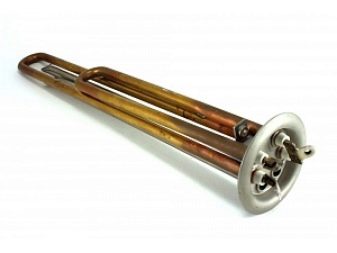

Open type elements have the following positive characteristics:
- the main advantage of wet heating elements is the high rate of water heating;
- products with this type of heating element have a low cost;
- high-quality products are additionally coated with glassy enamel, which reduces the risk of corrosion and scale formation on the base of the part.
The disadvantages of wet heating elements include a low level of product safety, as well as a significant decrease in heat transfer as a result of the formation of scale on the surface of the tube. As a result, more electricity will be consumed to heat the liquid in the boiler. In addition, the poor quality of urban water adversely affects the service life of such products.
Closed-type elements require placement inside a special ceramic flask, which provides heating of water. The part itself does not come into contact with the liquid, due to which it received the name "dry" heating element. The flask has high safety requirements, so the product is made of steatite or magnesium silicate. The raw material used for the manufacture of the heating element is stainless steel.
This configuration involves heating the liquid by transferring heat from the casing.
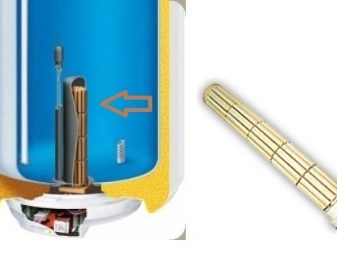

Closed-type heating elements have the following advantages:
- devices are distinguished by a high level of safety during operation, due to which the occurrence of a short circuit is not possible;
- the devices are convenient and easy to use;
- similar types of water heating products have a long service life;
- devices are economical;
- in the event of malfunctions, the products can be repaired.
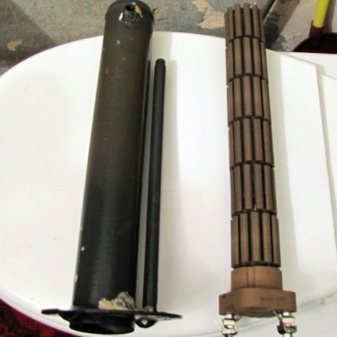

The disadvantages of such heaters include the fact that closed-type parts are made specifically for each model of a water heater. For this reason, in the event of a breakdown, the heating element can only be replaced with a similar part, which sometimes causes some difficulties.
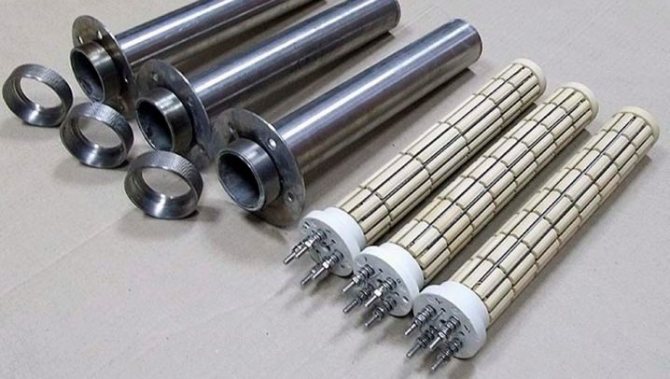

Flexible type devices
Such designs have found application in systems with hot channels, in molds.They are convenient when you need to shape the contour in a hot channel system. The sizes of electric heating elements can be any. A kind of flexible electric heating element that is familiar to almost every homeowner is a self-regulating cable for a warm floor. Such a heating element is very often used in the manufacture of a space heating system.
A separate type of device is a cartridge device, in which the terminals for connecting to the power source are on one side. The length of the heating element can be a maximum of 3.5 m. The main difference from all other types of devices is that it has a compact body, most often made of stainless steel with leads.
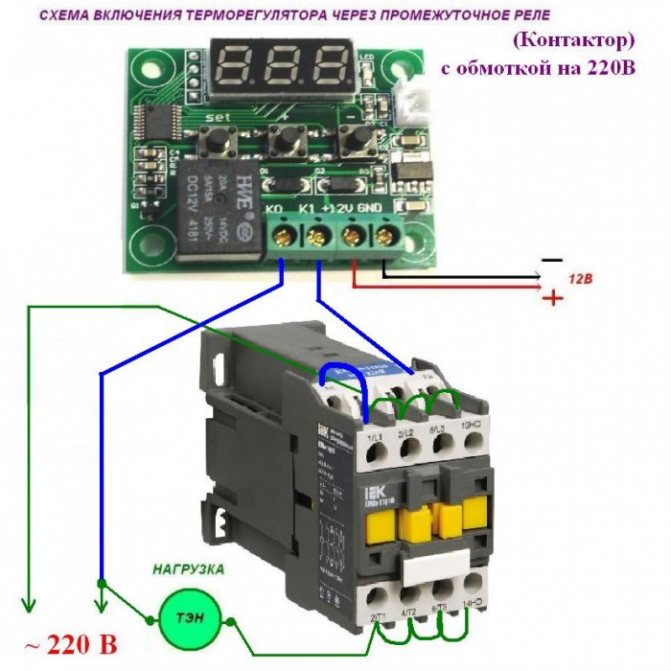

Cartridge heating elements have a very high power density, heat from the heating element is transferred both by convection and contact. Typically, such heaters are often used in the industry to heat oils of various shapes made of metal. Quite often, devices can be found in the automotive industry, footwear, food, and foundry.
Varieties of water electric heating elements
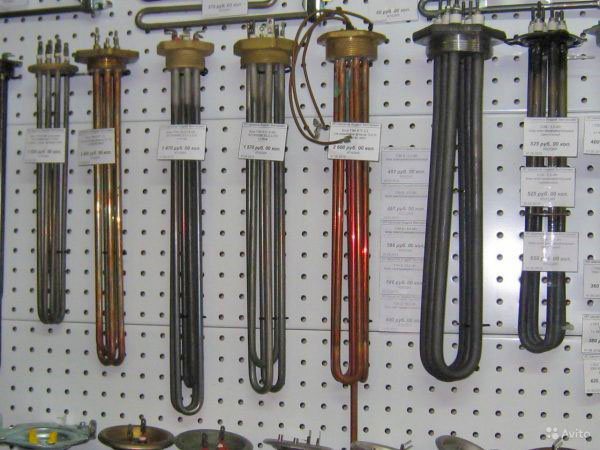

Let us recall the old open spiral electric cookers, which were used in the middle of the last century. If you cover such a spiral with a layer of clean fine sand and put it in a metal tube, close the ends with an insulating plug, you get a heating element for a water heater. The coiled wires do not come into contact with water and metal, but heat the copper or steel tube. As a result, there is no danger of electric shock, and the water heats up from a lowered, wet or open electrode.
To clean the heating element from scale, it must be immersed in hot water with antiscale or held in a citric acid solution. Then make sure the integrity of the case.
Another type of heating element is a design where the conductor is placed in a flask without contact with water. And such a device is considered a "dry" heating element or closed. Each of the elements has its own advantages and disadvantages.
Connecting devices
In order to connect the device to an alternating voltage network, you must use the diagrams given in the article. Be sure to install protection - a circuit breaker. In addition, you can install a magnetic starter to switch the circuit or an electromagnetic relay. If you need to adjust the temperature, install a special regulator - it is allowed to use both electronic and mechanical, operating on the principle of a thermostat. Now you know what a heating element is and what its types are, and most importantly, you have familiarized yourself with the connection diagrams.
General characteristics and principle of operation
Radiator heating element is a device that can be used as an additional or main heating device. The device consists of a cylindrical metal body. A copper spiral or steel wire is mounted in the middle of it. Internal parts are insulated.
The heating element designed for radiators is equipped with a thermostat. Due to this, the device can be used both for heating and for adjusting the temperature regime.
The principle of operation of such electrical appliances is quite simple:
- tubular electric heater is installed in the battery;
- the heating element is connected to the electrical network;
- the spirals are heated, due to which heat is supplied to the coolant.
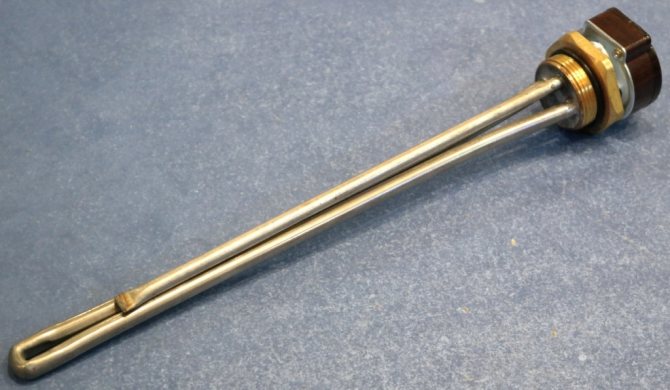

What does a heating element look like for a radiator
Setting the required temperature is allowed if there is a regulator in the device. When the level of the specified mode is reached, the electrical circuit is opened and the heating element is turned off. When the temperature falls below the set upper limit, automatic heating takes place. You can connect the heating element to almost any battery.
Where is the heating element of the washing machine installed?
In household washing units, so-called wet heating elements are used, the working element of which is located in the washing tank and is in direct contact with water. Locally, in washing units produced by different companies, heating elements can be placed both on both sides and in front and behind the washing machine.
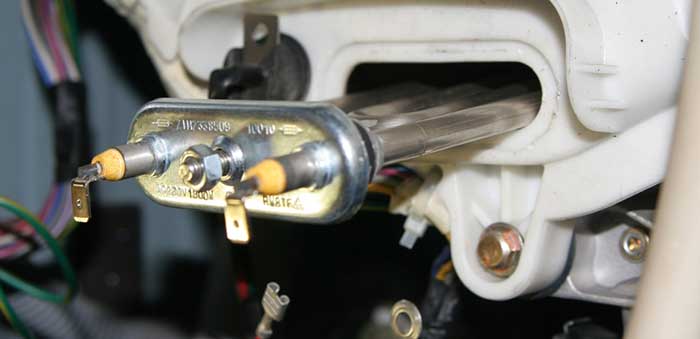

In front-loading machines, heating elements have a side arrangement. The only rule is to place it at the bottom of the washing tub to heat the water more efficiently. It is also known from the school physics course that the coldest layers of water are at the bottom, and when heated, they rise up. Natural convection of the liquid occurs, and its more efficient heating.

